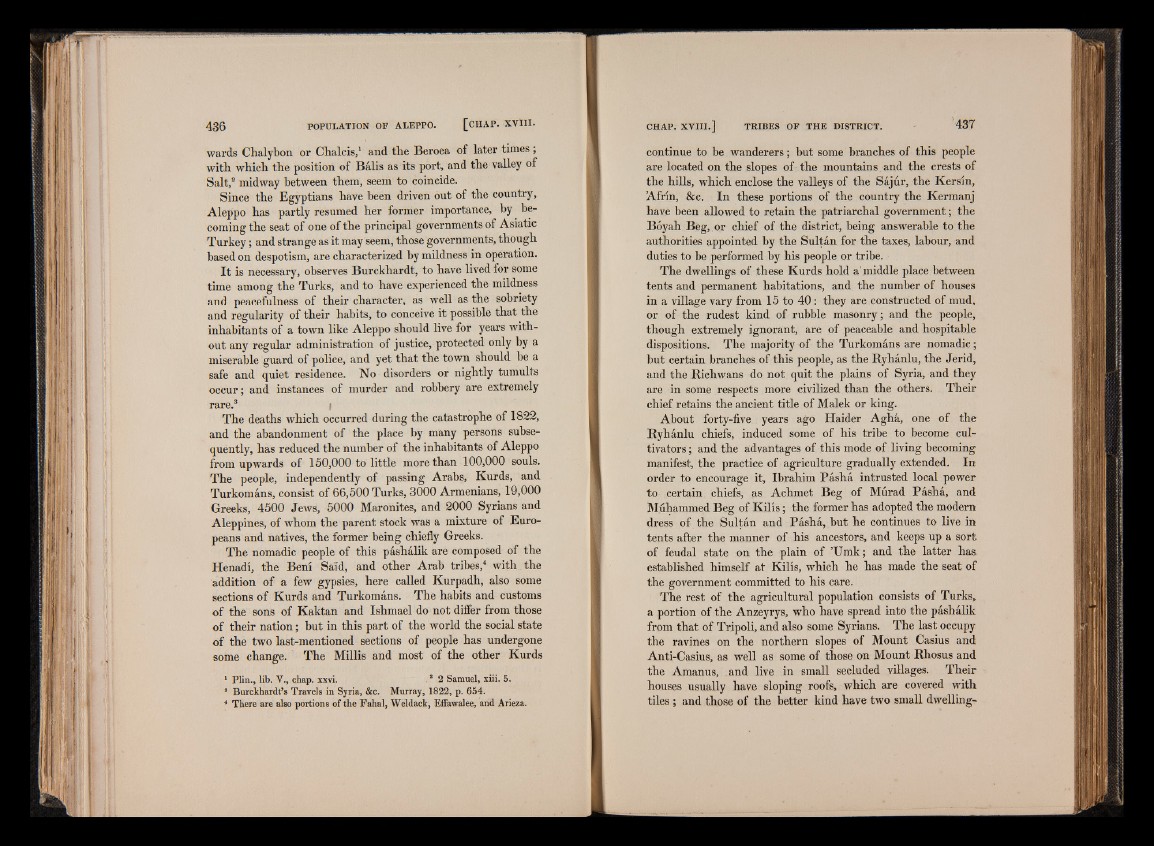
wards Chalybon or Chalcis,1 and the Beroea of later times ;
with which the position of Balis as its port, and the valley of
Salt,2 midway between them, seem to coincide.
Since the Egyptians have been driven out of the country,
Aleppo has partly resumed her former importance, by becoming
the seat of one of the principal governments of Asiatic
Turkey; and strange as it may seem, those governments, though
based on despotism, are characterized by mildness in operation.
It is necessary, observes Burckhardt, to have lived for some
time among the Turks, and to have experienced the mildness
and peacefulness of their character, as well as the sobriety
and regularity of their habits, to conceive it possible that the
inhabitants of a town like Aleppo should live for years without
any regular administration of justice, protected only by a
miserable guard of police, and yet that the town should be a
safe and quiet residence. No disorders or nightly tumults
occur; and instances of murder and robbery are extremely
rare.3 |
The deaths which occurred during the catastrophe of 1822,
and the abandonment of the place by many persons subsequently,
has reduced the number of the inhabitants of Aleppo
from upwards of 150,000 to little more than 100,000 souls.
The people, independently of passing Arabs, Kurds, and
Turkomans, consist of 66,500 Turks, 3000 Armenians, 19,000
Greeks, 4500 Jews, 5000 Maronites, and 2000 Syrians and
Aleppines, of whom the parent stock was a mixture of Europeans
and natives, the former being chiefly Greeks.
The nomadic people of this pashalik are composed of the
Henadi, the Beni Said, and other Arab tribes,4 with the
addition of a few gypsies, here called Kurpadh, also some
sections of Kurds and Turkomans. The habits and customs
of the sons of Kaktan and Ishmael do not differ from those
of their nation; but in this part of the world the social state
of the two last-mentioned sections of people has undergone
some change. The Millis and most of the other Kurds
1 Plin., lib. V., chap. xxvi. .1 2 Samuel, xiii. 5.
8 Burckhardt’s Travels in Syria, &c. Murray, 1822, p. 654.
* There are also portions of the Tahal, Weldack, Effawalee, and Arieza.
continue to be wanderers; but some branches of this people
are located on the slopes of the mountains and the crests of
the hills, which enclose the valleys of the Sájúr, the Kersin,
Afrin, &c. In these portions of the country the Kermanj
have been allowed to retain the patriarchal government; the
Bóyah Beg,, or chief of the district, being answerable to the
authorities appointed by the Sultán for the taxes, labour, and
duties to be performed by his people or tribe.
The dwellings of these Kurds hold a'middle place between
tents and permanent habitations, and the number of houses
in a village vary from 15 to 40: they are constructed of mud,
or of the rudest kind of rubble masonry; and the people,
though extremely ignorant, are of peaceable and hospitable
dispositions. The majority of the Turkomans are nomadic;
but certain branches of this people, as the Ryhánlu, the Jerid,
and the Richwans do not quit the plains of Syria, and they
are in some respects more civilized than the others. Their
chief retains the ancient title of Malek or king.
About forty-five years ago Haider Aghá, one of the
Ryhánlu chiefs, induced some of his tribe to become cultivators
; and the advantages of this mode of living becoming
manifest, the practice of agriculture gradually extended. In
order to encourage it, Ibrahim Páshá intrusted local power
to certain chiefs, as Achmet Beg of Murad Páshá, and
Mmhammed Beg of Kills; the former has adopted the modern
dress of the Sultán and Páshá, but he continues to live in
tents after the manner of his ancestors, and keeps up a sort
of feudal state on the plain of TJmk; and the latter has
established himself at Kilis, which he has made the seat of
the government committed to his care.
The rest of the agricultural population consists of Turks,
a portion of the Anzeyrys, who have spread into the páshálik
from that of Tripoli, and also some Syrians. The last occupy
the ravines on the northern slopes of Mount Casius and
Anti-Casius, as well as some of those on Mount Rhosus and
the Amanus, and live in small secluded villages. Their
houses usually have sloping roofs, which are covered with
tiles ; and those of the better kind have two small dwelling